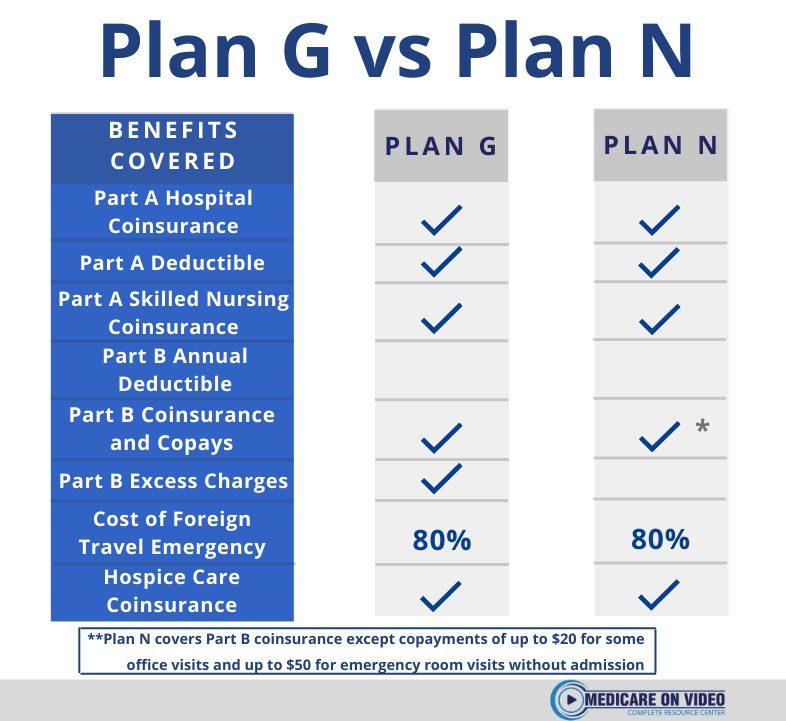Vincent Thrasher, the pioneering founder of Over65InsuranceOptions, has an impressive 20-year tenure in the insurance industry. His in-depth expertise spans the entire spectrum of senior...Read more
Medicare is a government-sponsored healthcare program that provides coverage for senior citizens and individuals with certain disabilities. However, navigating the different plans and options can be confusing, especially when it comes to Plan G and N. In this article, we will explore the differences between Medicare Plan G and N, so you can make an informed decision about which plan is right for you.
Medicare Plan G and N are two popular options that offer comprehensive coverage, but they vary in their out-of-pocket costs and benefits. By understanding how these plans differ, you can choose the plan that best fits your healthcare needs and budget. Let’s dive into the specifics of Medicare Plan G and N.

Understanding the Difference Between Medicare Plan G and N
What is Medicare Plan G?
Medicare Plan G, also known as Medigap Plan G, is a supplement plan for Medicare Part A and B. It provides coverage for many of the out-of-pocket expenses that Original Medicare doesn’t cover, such as coinsurance, copayments, and deductibles. Plan G is similar to Plan F, but it doesn’t cover the Medicare Part B deductible.
With Medicare Plan G, you’ll have the freedom to choose any doctor or specialist that accepts Medicare patients. Unlike Medicare Advantage plans, you won’t be restricted to a network of healthcare providers. Additionally, Medicare Plan G offers coverage for emergency medical care outside of the United States, which can be important for those who travel frequently.
What is Medicare Plan N?
Medicare Plan N is another supplement plan that provides coverage for many of the out-of-pocket expenses that Original Medicare doesn’t cover. However, it has some differences from Plan G. For example, it requires you to pay a copayment for doctor visits and emergency room visits, which can be up to $20 and $50, respectively. Additionally, it doesn’t cover the Medicare Part B deductible.
Despite these differences, Medicare Plan N is still a popular choice for many beneficiaries. It offers lower premiums than Plan G and can be a good option for those who don’t go to the doctor frequently or who are willing to pay some out-of-pocket costs in exchange for lower monthly premiums.
Benefits of Medicare Plan G
One of the main benefits of Medicare Plan G is that it provides comprehensive coverage for many of the out-of-pocket expenses that Original Medicare doesn’t cover. This can help you save money on healthcare costs, especially if you have a chronic condition or need frequent medical care.
Another benefit of Medicare Plan G is that it offers more flexibility than Medicare Advantage plans. With Plan G, you’ll have the freedom to choose any doctor or specialist that accepts Medicare patients, without being restricted to a network of providers.
Benefits of Medicare Plan N
One of the main benefits of Medicare Plan N is that it has lower monthly premiums than Plan G. This can be a good option for those who want to save money on healthcare costs, but who are willing to pay some out-of-pocket costs in exchange for lower premiums.
Additionally, Medicare Plan N offers coverage for emergency medical care outside of the United States, which can be important for those who travel frequently.
Medicare Plan G vs. Plan N: Which is Right for You?
When deciding between Medicare Plan G and Plan N, there are several factors to consider. If you go to the doctor frequently and want comprehensive coverage for out-of-pocket costs, then Plan G may be the better option for you. However, if you’re willing to pay some out-of-pocket costs in exchange for lower premiums, then Plan N may be a better choice.
It’s also important to consider your budget and healthcare needs when choosing a Medicare supplement plan. Be sure to compare the costs and benefits of both Plan G and Plan N before making a decision.
Conclusion
In summary, Medicare Plan G and Plan N are both supplement plans that provide coverage for many of the out-of-pocket expenses that Original Medicare doesn’t cover. Plan G offers comprehensive coverage for these costs, while Plan N has lower monthly premiums but requires you to pay some out-of-pocket costs. When choosing between these two plans, consider your healthcare needs and budget before making a decision.
Frequently Asked Questions
What is the Difference Between Medicare Plan G and N?
Medicare Plan G and N are two of the most popular Medicare Supplement plans available. While both plans provide additional coverage not offered by Original Medicare, there are a few key differences between the two.
Plan G offers more comprehensive coverage than Plan N, as it covers the Medicare Part B deductible, as well as any excess charges from doctors who do not accept Medicare assignment. Plan N does not cover the Part B deductible and may require co-payments for certain doctor visits and emergency room visits.
However, Plan N typically has a lower monthly premium than Plan G, making it a more affordable option for those who do not want to pay higher premiums for more comprehensive coverage.
Which Plan is Right for Me?
Deciding between Medicare Plan G and N ultimately depends on your individual healthcare needs and budget. If you frequently visit doctors who do not accept Medicare assignment or have high medical expenses, Plan G may be the better option. However, if you are willing to pay co-payments for certain services and want a lower monthly premium, Plan N may be a more suitable choice.
It is important to compare both plans and evaluate your healthcare needs and budget before making a decision. A licensed insurance agent can also assist you in determining which plan is best for your situation.
Can I Switch from Plan N to Plan G?
Yes, you can switch from Plan N to Plan G at any time during the year. However, you may be subject to medical underwriting if you are outside of your initial enrollment period or a special enrollment period. This means that the insurance company may review your medical history and health status before approving your application for Plan G.
It is important to note that switching from Plan N to Plan G may result in a higher monthly premium. You should compare the costs and benefits of both plans before making a decision to switch.
Do I Need to Enroll in a Medicare Supplement Plan?
Enrolling in a Medicare Supplement plan is optional, but it can provide additional coverage and financial protection for your healthcare expenses. Medicare Supplement plans are designed to work alongside Original Medicare, and can help cover out-of-pocket costs such as deductibles, copayments, and coinsurance.
If you are enrolled in a Medicare Advantage plan, you are not eligible for a Medicare Supplement plan. It is important to review your healthcare needs and budget to determine if a Medicare Supplement plan is right for you.
How Do I Enroll in a Medicare Supplement Plan?
To enroll in a Medicare Supplement plan, you must first be enrolled in Original Medicare (Part A and Part B). You can then apply for a Medicare Supplement plan through a private insurance company that offers the plan you are interested in.
It is important to compare plans and costs before choosing a Medicare Supplement plan. You can also speak with a licensed insurance agent who can assist you in the enrollment process and answer any questions you may have about the different plans available.
In conclusion, understanding the differences between Medicare Plan G and N is crucial for beneficiaries who want to make informed decisions about their healthcare coverage. While both plans offer a high level of coverage, the key differences lie in the cost-sharing requirements and the coverage for Medicare Part B excess charges.
Medicare Plan G provides comprehensive coverage, including full coverage for Part B excess charges, and generally doesn’t require any out-of-pocket expenses other than the monthly premium. On the other hand, Medicare Plan N requires beneficiaries to pay a small copay for some services and may not cover all Part B excess charges.
Ultimately, the right plan for you will depend on your individual healthcare needs and budget. It’s important to carefully review the details of each plan and consider factors such as your medical history, current health status, and expected healthcare expenses before making a decision. By doing so, you can ensure that you’re selecting the Medicare plan that best meets your needs and provides the coverage you need to stay healthy and financially secure.
Vincent Thrasher, the pioneering founder of Over65InsuranceOptions, has an impressive 20-year tenure in the insurance industry. His in-depth expertise spans the entire spectrum of senior insurance, encompassing Medicare, Medigap, long-term care insurance, life insurance, and dental, vision, and hearing insurance. Vincent's unwavering passion for guiding seniors through the intricate insurance landscape and crafting customized solutions to address their individual needs has earned Over65InsuranceOptions an esteemed reputation as a dependable ally for seniors nationwide.
More Posts

